Immo (died 859) was the bishop of Noyon from between 835 and 841 until his death at the hands of a group of Vikings. During the civil war that convulsed the Carolingian Empire following the death of Emperor Louis the Pious in 840, Immo supported the emperor's youngest son, Charles the Bald, from 841.
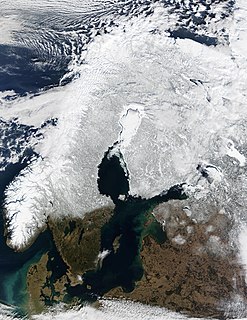
Vikings were Norse seafarers, mainly speaking the Old Norse language, who during the late 8th to late 11th centuries, raided and traded from their Northern European homelands across wide areas of Europe, and explored westwards to Iceland, Greenland, and Vinland. The term is also commonly extended in modern English and other vernaculars to the inhabitants of Norse home communities during what has become known as the Viking Age. This period of Nordic military, mercantile and demographic expansion constitutes an important element in the early medieval history of Scandinavia, Estonia, the British Isles, France, Kievan Rus' and Sicily.
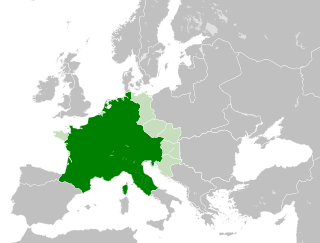
The Carolingian Empire (800–888) was a large empire in western and central Europe during the early Middle Ages. It was ruled by the Carolingian dynasty, which had ruled as kings of the Franks since 751 and as kings of the Lombards of Italy from 774. In 800, the Frankish king Charlemagne was crowned emperor in Rome by Pope Leo III in an effort to revive the Roman Empire in the west during a vacancy in the throne of the eastern Roman Empire. After a civil war (840–43) following the death of Emperor Louis the Pious, the empire was divided into autonomous kingdoms, with one king still recognised as emperor, but with little authority outside his own kingdom. The unity of the empire and the hereditary right of the Carolingians continued to be acknowledged, preceding the Holy Roman Empire, which lasted until 1806.

Louis the Pious, also called the Fair, and the Debonaire, was the King of the Franks and co-Emperor with his father, Charlemagne, from 813. He was also King of Aquitaine from 781.
A letter to Immo from his archbishop, Hincmar of Reims, survives from 846. Hincmar was summoning Immo the consecration of Ermenfrid as bishop of Beauvais, which was taking place in time for Ermenfrid to attend the synod of Paris on 14 February 846. Another surviving letter of Hincmar instructs Immo to assist in the consecration of bishop Pardulus of Laon in 847.
Pardulus of Laon was bishop of Laon from 847 to 857. He is known for his participation in theological controversy. A letter of his to Hincmar of Reims is known.
In 859, probably late in August, according to the Annales Bertiniani , "Vikings attacked Noyon by night and took captive Bishop Immo and a number of other nobles, both clerics and layment." The bishop was killed "on the march", perhaps because he tried to resist or escape. The acts of the synod of Tuzey, which opened on 22 October 860, are signed by Immo and his successor, Raginelm. The contradictory signatures were already dismissed as a forgery by Hincmar. Nevertheless, some modern scholars have dismissed the Annales as mistaken and placed Immo's either between the opening of the synod and its closing (7 November) or after the synod (as late as 861).
Annales Bertiniani are late Carolingian, Frankish annals that were found in the Abbey of Saint Bertin, Saint-Omer, France, after which they are named. Their account is taken to cover the period 830-82, thus continuing the Royal Frankish Annals (741–829), from which, however, it has circulated independently in only one manuscript. They are available in the Monumenta Germaniæ Historica and in a later French edition taking into account a newly discovered manuscript . The Annals of St. Bertin are one of the principal sources of ninth-century Francia, and are particularly well-informed on events in the West Frankish sphere of Charles the Bald. The Annales Fuldenses are usually read as an East Frankish counterpart to their narrative.
This page is based on this
Wikipedia article Text is available under the
CC BY-SA 4.0 license; additional terms may apply.
Images, videos and audio are available under their respective licenses.

Year 859 (DCCCLIX) was a common year starting on Sunday of the Julian calendar.

Nominoe or Nomenoe was the first Duke of Brittany from 846 to his death. He is the Breton pater patriae and to Breton nationalists he is known as Tad ar Vro.
Hincmar, archbishop of Reims, was the friend, advisor and propagandist of Charles the Bald. He belonged to a noble family of northern Francia.

Rorik was a Danish Viking, who ruled over parts of Friesland between 841 and 873, conquering Dorestad and Utrecht in 850. Rorik swore allegiance to Louis the German in 873. He died at some point between 873 and 882.

Ebbo or Ebo was archbishop of Rheims from 816 until 835 and again from 840 to 841. He was born a German serf on the royal demesne of Charlemagne. He was educated at his court and became the librarian and councillor of Louis the Pious, king of Aquitaine, son of Charlemagne. When Louis became emperor, he appointed Ebbo to the see of Rheims, then vacant after the death of Wulfaire.
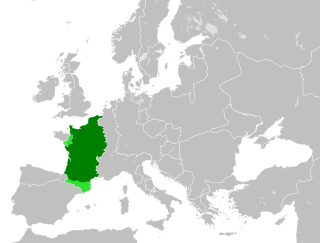
In medieval historiography, West Francia or the Kingdom of the West Franks was the western part of Charlemagne's Empire, ruled by the Germanic Franks that forms the earliest stage of the Kingdom of France, lasting from about 840 until 987. West Francia was formed out of the division of the Carolingian Empire in 843 under the Treaty of Verdun after the death of Emperor Louis the Pious and the east–west division which "gradually hardened into the establishment of separate kingdoms (...) of what we can begin to call Germany and France."
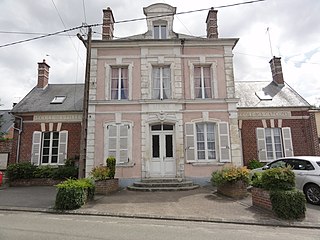
Quierzy is a commune in the Aisne department in Hauts-de-France in northern France, straddling the Oise River between Noyon and Chauny.

Rodulf was the archbishop of Bourges from 840 until his death. He is remembered as a skillful diplomat and a proponent of ecclesiastical reform. As a saint, his feast has been celebrated on 21 June.
Frothar or Frotar was an Aquitanian prelate in West Francia, who held two different bishoprics and three abbacies during a long career. He was appointed Archbishop of Bordeaux around 859, but Viking raids forced him to abandon his seat in 870. With papal approval, he was transferred to the archdiocese of Bourges in 876. He died after 893.
Wilbert was the archbishop of Cologne from 870 until his death.
Bjørn was a Viking chieftain. He is the earliest known Scandinavian who was not a relative of the Danish kings to enter the service of a Frankish king, in his case Charles the Bald, king of West Francia. He is sometimes tenuously identified with the Swedish king Björn Ironside.
Wulfad was the archbishop of Bourges from 866 until his death. Prior to that, he was the abbot of Montier-en-Der and Soissons. He also served as a tutor to Carloman, a younger son of King Charles the Bald. Carloman succeeded Wulfad as abbot of Soissons in 860.
Wenilo was the archbishop of Rouen from 858. He was an appointee of King Charles the Bald.
Wenilo was the archbishop of Sens from 836 or 837. Prior to becoming bishop, Wenilo was a palatine chaplain. As bishop, he was one of the leading men in Aquitaine and crowned Charles the Bald king in 848, definitively uniting Aquitaine with West Francia. In 858, he supported the East Frankish invasion and was denounced as a traitor by the king. He reconciled the next year, and retained his office until his death. Nevertheless, Wenilo passed into legend as Ganelon, the archvillain of the Matter of France, his name a byword for "traitor".
Ragenar was the bishop of Amiens from 830 to 833 and again from 834 until his death in 849. His predecessor, Jesse, was initially deposed by the Emperor Louis the Pious in 830 for conspiring with his rebellious son Lothair. In 833 he was restored when Lothair forced his father to make public obeisance at an assembly in Soissons. When Louis regained his position in 834, Jesse was again deposed and this time exiled to Italy, where he died in 836.
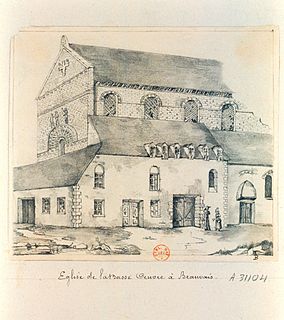
Odo I was a West Frankish prelate who served as abbot of Corbie in the 850s and as bishop of Beauvais from around 860 until his death in 881. He was a courtier and a diplomat, going on missions to East Francia and the Holy See.
Guntbold was the archbishop of Rouen from 836 until his death in 849.
The Capitulary of Servais was the implementation of an agreement between Charles the Bald and his half-brother Lothar to maintain the peace. In a conference of Charles and Lothar at Valenciennes in 853, the missi [literally, the sent ones] were re-established after a long hiatus. Lothar recommended that peace and justice be secured by sending out missi to enforce the laws and help keep the peace. The Diet of Servais confirmed the decisions arrived at during the conference. The Capitulary of Servais was enacted by Charles in November 853 dividing the Franco-Burgundian portion of Charles’ realm into twelve districts (missatica) to enforce the measures of this agreement. According to Nelson, the twelve missicati and associated missi were:










